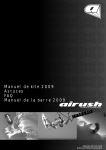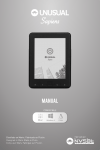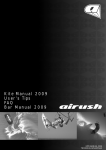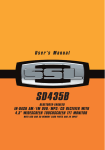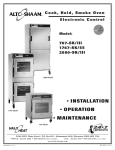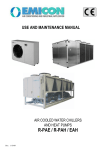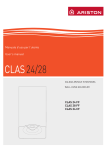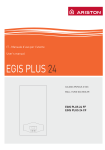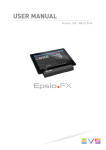Download Wilton 1230 Operating instructions
Transcript
Radial Arm Drill Press Model 1230 Operating instructions and parts manual Part No. 9078241 Revision A Table of Contents Cover Page ........................................................................................................................ 1 General Specifications ...................................................................................................... 4 Operating Precautions ...................................................................................................... 5 Operating Instructions ....................................................................................................... 7 Lubrication and Coolant ................................................................................................ 13 Machine Set-up ............................................................................................................... 14 Wiring Diagram................................................................................................................. 16 Replacement Parts .......................................................................................................... 17 3 General specifications The Wilton Model 1230 is a powerful and versatile radial arm drill press. The drill head is mounted on an arm and can move along the arm to position the spindle over the work piece. The arm, itself, can be rotated on its support column to allow centering the spindle over the work piece. Drilling can be performed manually or with power assistance. In addition, parameters of RPM, power feed rate and drilling depth can be pre-set by the operator, using controls conveniently positioned on the drill head, to allow any hole to be drilled using power feed. A precision machined box table is delivered with the Model 1230 to allow convenient positioning and clamping of smaller work pieces. The box table may be removed from the base to allow larger workpieces to be positioned and clamped on the precision machined base, itself. Machining capacities Steel Cast iron Drilling 2 1/8 in. (53mm) 2 1/2 in. (63mm) Tapping 1 1/8 in. (28mm) 1 3/4 in. (44mm) Boring 3 3/8 in. (84mm) 4 3/4 in. (119mm) Overall dimensions and specifications 4 Column diameter Column to spindle center distance, max. Column to spindle center distance, min. Spindle travel along arm, total Base surface to spindle end, max. (no tooling) Base surface to spindle end, min. (no tooling) Quill (spindle) travel Arm movement range on support column Box table dimensions Base dimension Spindle taper Spindle speeds, RPM Feed rates (distance/revolution) Main motor HP Arm raising motor HP Clamping motor Coolant pump motor HP Machine height (floor to max.) Net weight (approx) 11 13/16 in. (295mm) 46 in. (1150mm) 13 3/8 in. (334mm) 35 in. (875mm) 54 in. (1350.0mm) 19 3/8 in. (484mm) 9 7/8 in. (247mm) 34 5/8 in. (866mm) 27 7/8 x 20 1/2 x 16 1/2 in. (697x513x413mm) 67 3/4 x 25 15/16 x 6 1/2 in. (1694x648x163mm) Morse #4 45-1550 0.002, 0.004, 0.006 in/rev (0.005, 0.010, 0.030 mm/rev) 5 1 1 1/8 109 1/2 in. (2,738mm) 4,620 lb. (2,100 kg) - Misuse of this machine can cause serious injury. - For safety, machine must be set up, used and serviced properly. - Read, understand and follow instructions in the operator’s and parts manual which was shipped with your machine. When setting up machine: - Always avoid using machine in damp or poorly lighted work areas. - Always be sure machine is securely anchored to the floor. - Always keep machine guards in place. - Always put start switch in “OFF” position before plugging in machine. When using machine: -Never operate with machine guards missing. -Always wear safety glasses with side shields (See ANSI Z87.1) -Never wear loose clothing or jewelry. -Never overreach — you may slip and fall into the machine. -Never leave machine running while you are away from it. -Always shut off the machine when not in use. When servicing machine: -Always unplug machine from electrical power while servicing. -Always follow instructions in operators and parts manual when changing accessory tools or parts. -Never modify the machine without consulting Wilton Corporation. You — the stationary power tool user — hold the key to safety. Read and follow these simple rules for best results and full benefits from your machine. Used properly, Wilton’s machinery is among the best in design and safety. However, any machine used improperly can be rendered inefficient and unsafe. It is absolutely mandatory that those who use our products be properly trained in how to use them correctly. They should read and understand the Operators and Parts Manual as well as all labels affixed to the machine. Failure in following all of these warnings can cause serious injuries. Machinery general safety warnings 1. Always wear protective eye wear when operating machinery. Eye wear shall be impact resistant, protective safety glasses with side shields which comply with ANSI Z87.1 specifications. Use of eye wear which does not comply with ANSI Z87.1 specifications could result in severe injury from breakage of eye protection. 2. Wear proper apparel. No loose clothing or jewelry which can get caught in moving parts. Rubber soled footwear is recommended for best footing. 3. Do not overreach. Failure to maintain proper working position can cause you to fall into the machine or cause your clothing to get caught — pulling you into the machine. 4. Keep guards in place and in proper working order. Do not operate the machine with guards removed. 5. Avoid dangerous working environments. Do not use stationary machine tools in wet or damp locations. Keep work areas clean and well lit. Special electrics should be used when working on flammable materials. 6. Avoid accidental starts by being sure the start switch is “OFF” before plugging in the machine. 7. Never leave the machine running while unattended. Machine shall be shut off whenever it is not in operation. 8. Disconnect electrical power before servicing. Whenever changing accessories or general maintenance is done on the machine, electrical power to the machine must be disconnected before work is done. 9. Maintain all machine tools with care. Follow all maintenance instructions for lubricating and the changing of accessories. No attempt shall be made to modify or have makeshift repairs done to the machine. This not only voids the warranty but also renders the machine unsafe. 10. Machinery must be anchored to the floor. 11. Secure work. Use clamps or a vise to hold work, when practical. It is safer than using your hands and it frees both hands to operate the machine. 12. Never brush away chips while the machine is in operation. 13. Keep work area clean. Cluttered areas invite accidents. 14. Remove adjusting keys and wrenches before turning machine on. 15. Use the right tool. Don’t force a tool or 5 attachment to do a job it was not designed for. 16. Use only recommended accessories and follow manufacturers instructions pertaining to them. 17. Keep hands in sight and clear of all moving parts and cutting surfaces. 18. All visitors should be kept at a safe distance from the work area. Make workshop completely safe by using padlocks, master switches, or by removing starter keys. 19. Know the tool you are using — its application, limitations, and potential hazards. General Electrical Cautions Wire sizes Caution: for circuits which are far away from the electrical service box, the wire size must be increased in order to deliver ample voltage to the motor. To minimize power losses and to prevent motor overheating and burnout, the use of wire sizes for branch circuits or electrical extension cords according to the following table is recommended: AWG (American wire gauge) number 240 volt lines 120 volt lines No. 14 No. 14 No. 14 No. 12 No. 12 No. 8 This machine should be grounded in accordance with the National Electrical Code and local codes and ordinances. This work should be done by a qualified electrician. The machine should be grounded to protect the user from electrical shock. Conductor length 0-50 feet 50-100 feet Over 100 feet Safety instructions on drill presses 6 1. All work shall be secured using either clamps or a vise to the drill press table. It is unsafe to use your hands to hold any workpiece being drilled. 2. Drill press head and table shall be securely locked to the column before operating the drill press. This must always be checked prior to starting the machine. 3. Always use the correct tooling. Tooling shall always be maintained and properly sharpened. All tooling must be run at the proper speeds and feeds as they apply to the job. Use only recommended accessories and follow those manufacturers instructions pertaining to them. Tooling shall not be forced in to any workpiece but fed according to the proper specifications. Failure to follow these instructions will not only ruin the tooling as well as the machine, but can cause serious injury. 4. Never brush away any chips while the machine is in operation. All clean up should be done when the machine is stopped. 5. Keep hands in sight. Do not put hands or fingers around, on, or below any rotating cutting tools. Leather safety gloves should be used when handling any sharp objects or cutting tools. See Figure A. 6. Always wear protective eye wear when operating, servicing or adjusting machinery. Eyewear shall be impact resistant, protective safety glasses with side shields complying with ANSI Z87.1 specifications. Use of eye wear which does not comply with ANSI Z87.1 specifications could result in severe injury from breakage of eye protection. See figure B. 7. When drilling in material which causes dust, a dust mask shall be work. See Figure C. 8. Avoid contact with coolant, especially guarding the eyes. 9. Non-slip footwear and safety shoes are recommended. See figure D. 12. Wear ear protectors (plugs or muffs) during extended periods of operation. See figure E. Operating Instructions Clamping workpieces to the machine Both the box table and the base surface are slotted to accept a suitably sized T-slot clamp. Before begining any work on the drill press, anchor the work piece, and the box table, too, if used, to be certain the workpiece and/or box table will not move when the drill, tap or boring tool enters the workpiece. Caution Failure to properly anchor the workpiece and box table could result in damage to the machine, damage to the workpiece, and worse -severe injury and possibly death to the machine operator. Never work on the drill press without clamping the materials using a T-slot system setup. Figure 1: Drill press nomenclature 7 Inserting tooling The Model 1230 uses a #4 Morse taper in the spindle to secure tooling. Any drill, milling cutter, or tool holder with a #4MT can be inserted into the quill. Caution The first step in removing or inserting any tooling is to be absolutely certain the machine cannot be accidentally started during the insertion or removal operation. The only way to be certain of this fact is to disconnect power to the machine using the service box cut-out switch. The service box (typically the one holding the fuses or circuit breakers will have been installed by the electrician who connected the machine to its service branch) should have a cut-out switch or lever on the outside of the box. Put the switch or lever in the OFF position before inserting or removing tooling. To insert tooling: 1. Observe the caution, above, and be certain all power to the machine has been disconnected. 2. Be certain the spindle is clean, free from oil, and ready to accept the shank of any tooling. 3. Check the shank of the tooling to be certain the tooling is free from dirt, nicks or burrs. If any nicks or burrs are discovered, file and/or stone the shank until the shank is smooth. 4. Be certain the quill is in the full UP position. 5. Slide the shank of the tooling into the spindle until it seats. 6. Use a soft-faced mallet (such as lead, plastic, brass, etc.) to give the tooling a sharp tap on its tip. This will secure the tooling firmly in the taper. 7. Re-establish power to the machine and the drill is ready to use. 8 To remove tooling: 1. Observe the caution above and be certain all electrical power to the drill press has been cut off. 2. Place a wood block under the tooling in the spindle to prevent it from being damaged, should it fall out of the quill during the removal process. 3. Lower the quill by using the feed levers until the tool removal window is exposed. 4. Using a suitable tapered drift, insert the drift in the removal window, above the tip of the tooling shank. 5. Using leather gloves to prevent cuts from the tooling, hold the tooling with you hand to prevent it from falling from the quill. 6. With your free hand, using a hammer, tap the tapered drift and the tooling will loosen from the taper and can be removed. The spindle is now ready for the insertion of other tooling with a #4 MT. Positioning the tooling over the workpiece. After the workpiece has been clamped to the base or table you can position the tooling over the workpiece by doing any or all of the following: 1. Adjusting the height of the arm on the support column. 2. Moving the drill head along the arm. 3. Rotating the column upon which the arm and head are attached. Unlocking the arm and column mechanisms A motorized locking system is used to lock the head to the arm, the arm to the column, and the column to the base. The lock and unlock buttons which control the locks are located on the right-hand side of the drill head. When you push UNLOCK, all of the locks are unlocked. When you push LOCK, all of the locks are locked. Caution Always be certain the locks are engaged before using the drill press. Pull on the arm handle and try to rotate the head locating wheel before pushing the spindle ON button. Failure to have all locks locked may result in damage to tooling, damage to the work piece, and possible injury to the operator. Raising and lowering the radial arm 1. Power to the drill press must be ON -- then release the machine locks by pushing the UNLOCK push button. 2. Use the control lever -- push it upward or downward as required -- (see Fig. 3) to raise or lower the arm to the required height. See also, Using the control lever. 3. When the arm is at the required height and if no other adjustments to spindle location are required, push the LOCK push button to re-lock all machine locks. To move the drill head along the arm 1. Power to the drill press must be ON -- then release the machine locks by pushing the UNLOCK push button. 2. Using the wheel in the center of the drill head, turn the wheel to move the drill head along the arm. (See Fig. 1.) 3. When the drill head is at the desired position on the arm and if no other adjustments to spindle location are required, push the LOCK push button to re-lock all machine locks. CAUTION NEVER swing the drill press arm using the support column unless you are absolutely certain the drill press base is firmly attached to the shop floor. You can tell if the base is bolted to the floor by checking the mounting pads at the four corners of the base. There should be a securing bolt through each mounting pad. If the arm is moved off of its position directly above the base and the base is not bolted to the floor, THE DRILL MAY TIP OVER AND CAUSE SERIOUS INJURY OR DEATH TO THE DRILL PRESS OPERATOR (YOU!!) and will certainly result in serious damage to the drill press, itself. Don't take chances. Always look for bolts at the mounting pads before swinging the drill press arm. Moving the arm on the support column 1. Power to the drill press must be ON -- then release the machine locks by pushing the UNLOCK push button. 2. Use the handle at the end of the arm (see Fig. 1) to move the column (and, therefore, to swing the arm) as necessary to the required spindle position. 3. When the spindle is positioned correctly and no other adjustments are quired, push the LOCK push button to re-lock all machine locks. on LOW or HI speed. There is a chart on the front of the drill head which shows you the spindle speeds available and the gear change lever and motor switch values required to select each speed. See Fig. 1. On the gear change table you will also find the recommended drill sizes for the various speeds which are selectable. THESE RECOMMENDATIONS ARE ONLY APPROXIMATE. With the wide variety of drill types and coatings available, the variety of cutting fluids which might be used, and the even wider variety of work piece materials which you might be machining -- you need to consult with your tooling, coolant and/or work piece suppliers to determine the best spindle speed to use for any specific drilling operation. Caution Do not try to change gears while the spindle is turning. This may cause serious damage to the spindle drive system. Allow the spindle to come to a complete stop before attempting to change gears. If the gear change lever you want to move does not slip easily into the new position you require, jog the motor for a second using the control lever. Then allow the spindle to come to a stop again before attempting to change gears, again. Repeat this jogging process, as necessary, until the gears match up properly for changing. Setting spindle speed Spindle speeds are established using the gear change levers on the upper right-hand side of the drill head. (See Fig. 1.) The shorter of the two levers operates a two-speed mechanism which puts the gearbox in either high gear or low gear. There is a "HI/LOW" readout on the upper left hand side of the drill head which tells you which speed range is selected. The longer gear change lever operates a three speed gearbox mechanism. The lowest gear and spindle speed is selected by pushing the lever away from you -- that is, by rotating the change shaft counterclockwise. The highest gear and spindle speed is selected by pulling the lever toward you -rotating the shaft clockwise. There is a detent in the middle of the lever travel to tell you when the lever is in the intermediate gear position. This gearbox set-up gives you a total of six spindle speeds which may be selected. The twospeed spindle drive motor, therefore, increases the number of available spindle speeds to 12. The specific spindle speed selected clearly depends on the position of both gear change levers and whether the motor switch on the top front of the drill head is Setting feed rate and depth of cut The Model 1230 has limit switches on the quill which cuts off electric power to the drive motor when the quill has reached either the upper or lower limit of its travel. This system is designed to prevent gearbox damage if the power feed mechanism is engaged -damage which would occur if the quill were to bottom out against the upper or lower limit of quill travel. In the event of failure of either limit switch there is also a safety clutch mechanism which will slip when the limits of travel are reached. However, while you are able to use virtually the full travel of the quill for drilling or other operations, the drill press operator typically sets both the rate of feed -- travel-per-revolution of the spindle -- and the depth of cut -- that is, the total distance the quill moves to make the required depth of cut. These two operations are described, here: Setting feed rate The feed rate is set using the knob and dial on the front of the drill head. See Fig. 1. The knob on the dial can be rotated to select any of three different 9 feed rates, plus a neutral position where the power feed does not operate on the quill. It is recommended that when doing operations which do not require power feed that the dial be set to the neutral position. This minimizes any wear on the power feed mechanism. The feed rate selected is indicated by a pair of rivet heads on the edge of the rate setting dial. These values are indicated on the far outer edge of the readout. Clearly, whenever the indicator rivets are at an "N" position, no feed or "neutral" has been selected. Any of the three feed rates are available for selection using any of the spindle speeds available. There will be a recommended feed rate for any drilling or boring operation, and this rate must be determined by consulting appropriate machining handbooks or by consulting with your tooling, coolant and work piece suppliers. Setting depth of cut using the power feed system There is a mechanism for engaging the power feed and there is also a mechanism (a "trip mechanism) which can be set to disengage the power feed when a pre-set depth has been reached. The feed levers can be pulled outward -- or pushed inward -- on pivots which are in the feed lever hub. When the feed levers are pushed toward the drill head, the power feed mechanism is disengaged. When the feed levers are pulled outward, the power feed system is engaged. In the power feed position (outward) the quill and spindle will be driven EITHER until they reach the limit of travel and the limit switches cut off power -- OR until the trip mechanism disengages the power feed, automatically -- OR until the drill press operator pushes the feed levers into the disengaged position. To set the depth of cut 1. Unlock lever A -- See Fig. 2. 2. Use the feed levers to lower the drill until it touches the work piece. 3. Rotate the dial D until the rivet on the dial -- C -- is at the feed depth required on the scale on graduated dial B. 4. Lock lever A. 5. Pull the feed levers out to engage the power feed clutch. Note: Because the ring for Dial B makes one rotation before contacting the mechanical trip dog, you are limited to 4 inches (100mm) of travel during any power feed operation. If you need to make deeper holes you will need to do the machining in steps. 10 Figure 2: Power feed controls Spindle direction and power feed The spindle can be driven clockwise or counterclockwise. The direction of rotation is controlled by the control lever on the left hand side of the drill head. See Fig. 1. Clockwise or "forward" rotation is the direction of rotation for right-hand tooling -- which is the vast majority of tooling used in machine operations. However, if you use left-hand tooling for any operations, the spindle direction can be set to counterclockwise or "reverse." The power feed direction is determined by the spindle direction. When the spindle is set to its most common direction -- clockwise or forward -- the quill and spindle are driven downward. When the spindle direction is set to counterclockwise or reverse direction, the quill and spindle are driven upward. Hand feed -- roughing operations When the feed levers are pushed toward the drill head the power feed mechanism is disengaged. In this position, the feed levers can be used to move the quill and spindle and perform manual drilling or other machining operations. Fine hand feed using the power feed system The fine feed control wheel is located on the underside of the right-hand side of the drill head. See Fig. 1. The fine feed control is used as follows: 1. Set the feed rate dial to N -- neutral. 2. Pull the feed levers out so the power feed clutch is engaged. 3. Turn the drill press POWER switch ON and set the control lever so the spindle is turning in the correct direction for the operation you are performing. 4. Turn the fine feed control wheel by hand. The quill and spindle will move downward or upward (depending upon which way you turn the wheel and the direction the spindle is turning) until you stop turning the control wheel. Power ON and power OFF If your Model 1230 was connected to its service branch correctly, there will be a service disconnect with an external power cutoff lever or switch which disconnects the drill press from the service branch. This is your ultimate protection against accidental machine start-up when clamping work pieces to the machine and/or inserting or removing tooling. Always be certain you have turned off power at this disconnect before doing these operations. Once your workpiece is clamped securely and the tooling is installed, you can restablish power to the machine by turning the cut-out panel back ON. This will reestablish power to the machine control system and will allow you to use the motor which raises and lowers the arm to position the tooling over the work piece. Raising and lowering of the arm is controlled by the control stick -- see Fig. 3 and read page 7, Raising and lowering the radial arm. Power ON light When the cutout box power is ON, the POWER light on the upper left hand side of the drill head (Fig. 1) will be lit. In this mode, power to the coolant pump and to the spindle drive motor is controlled by the switches on the control console. Flood coolant control The flood coolant system provided with the drill press is turned on by turning the switch to the ON position. Power OFF to the coolant pump is achieved by turning the switch counterclockwise to its OFF position. (If coolant does not flow, check the pump rotation by observing the pump shaft. It should be rotating in the direction of the arrow on the pump casting. If it is not rotating in the correct direction, see Electrical, for more information.) Spindle motor controls The power to the spindle motor controlled as follows: 1. The cutout box control lever must be in the ON position so power is being fed to the drill press. 2. The two speed spindle drive motor switch must be in either HI or LOW position. 3. The control ON/OFF switch must be pushed ON. 4. The arm/spindle control lever must be pulled forward (clockwise rotation) or backward (counterclockwise rotation.) See Using the control lever, page 11. Turning spindle drive motor power OFF To turn power OFF on the spindle drive motor do one of the following: 1. Put the two speed motor switch in OFF position, OR... 2. Push the Control ON/OFF switch off, OR... 3. Put the arm/spindle control lever in its middle (neutral) position, OR... 4. Push the large, red emergency off STOP switch, OR... 5. When servicing the tooling or other machine components, put the service disconnect lever in OFF position. Once the STOP switch has been pushed (4., above) none of the other switches on the panel can be used to control power to the spindle drive motor or coolant pump until the STOP switch has been re-set. 11 Resetting the STOP switch Using the control lever 1. Turn the switch in the direction of the arrow on the red button -- clockwise. The switch is reset and the other spindle motor controls can be used. The four-position control lever is located on the left hand side of the drill head console. See Figs. 1 and 3. The control lever can move up or down, backward or forward, or can be left in its most central, OFF or neutral position so no functions are under its control power. The control lever moves up or down to move the arm up or down when positioning the tooling over the work piece. This ability to control the height of the arm is available when: 1. The main power to the machine is ON at its branch service panel. 2. The emergency STOP switch is set to its ON mode. 3. The Control ON/OFF switch (lower left hand side of the face of the drill head, see Fig. 1) pushed ON. 4. The column and arm UNLOCK button (right hand side of the drill head -- see Fig. 1) is pressed to unlock the machine locks. See page 6. The control lever does not return to neutral when it is released. It stays in the position in which you have placed it. This means unless you return it to neutral, the arm will keep raising or lowering until it contacts one of its limit switches. When the motor speed control switch has been set to either HI or LOW position, the control lever can be moved backward or forward to turn the spindle drive motor ON and control the direction of rotation of the spindle. The control lever is not spring loaded to return to the neutral or OFF position when you Using the load ammeter An ammeter on the control console is used to monitor the load on the spindle drive motor. It is connected into one of the three power lines which supply the main drive motor. When the drive motor is ON and up to speed, and there is no tooling being used to drill, tap or bore a hole, the ammeter should read approximately 2.5 amps. If it is above this value there is a problem internally (such as lack of lubrication in the gearboxes, bad bearings, etc.) which means you should turn off the machine and determine the cause of the excessive free-running load. Monitor the the ammeter during machining operations. The ammeter should stay below 9 amps or current draw during machining. You should adjust your spindle speed, feed rate and coolant use to maintain the full load current draw below the 9 amp value. If you exceed 9 amps current draw a thermal limiter switch in the electrical control panel will trip. If this occurs, a licensed electrician should be used to locate and re-set the thermal limiter switch. Tapping operations 12 When performing tapping operations : 1. Determine the most efficient tapping speed (spindle speed) by consulting appropriate machinist's tables, your tap supplier, coolant supplier and/or work piece supplier. 2. Be certain the power feed dial is in N or neutral position. See Setting power feed rate, page 8. 3. Turn the spindle motor ON. Also, turn on the coolant pump if coolant is being used. 4. Move the control lever to FORWARD. 5. Use the feed levers to move the tap into its pilot hole until the tap makes its initial thread cut and is engaged in the workpiece. 6. Allow the tap to "self feed" into the pilot hole until it has completed its tapping operation. 7. Move the control lever into its center/neutral position until the spindle has come to a complete stop. 8. Move the control lever into its reverse direction so the tap unscrews itself from the hole it has just threaded. Figure 3: Control lever for spindle and arm. release it. Rather, the lever stays in the position in which you put it when you are controlling the spindle. There is no need to hold it in position to keep the spindle running. All of these functions are clearly labeled on the plate which surrounds the control lever and boot. Periodic maintenance The only maintenance for the Model 1230 is lubrication and changing of the coolant according to the schedule, below. Item Oiling cup Oiling cup Oiling cups Arm raising worm Sight glass Location Top and bottom of arm at column Top of drill head Right hand side of drill head Rear of column On drill head Lift chains Ways Coolant On rear of arm On arm In tank Oil fitting Rack On quill On arm Action Add lubricant with lube gun Interval Daily Lubricant Mobil Vactra oil AA Add lubricant with lube gun Add lubricant with lube gun Daily Daily Mobil Vactra oil AA Mobil Vactra oil AA Oil using lube gun Daily Mobil Vactra oil AA Check for level -- fill through pipe plug hole top of drill head Lubricate with lube gun Lubricate with lube gun Monitor for cleanliness and efficiency. Replace when dirty or when cutting becomes inefficient Lubricate with gun Lubricate with gun Daily Mobil Vactra oil AA Weekly Twice daily When cutting Mobil Vactra oil AA Mobil Vactra oil AA Daily Every 3 days Mobil Vactra oil AA Mobil Vactra oil AA 13 Figure 4: Lubrication diagram Machine set-up 1. Lift the drill press from its shipping skid according to the diagram, below. 2. Secure the drill press to the floor The drill press MUST be anchored to the floor according to the layout diagram below. Failure to anchor the machine properly, according to these diagrams, could result in the machine tipping over and consequent damage to the machine and possible injury or DEATH to the machine operator and bystanders. 3. Connect the electrical service branch to the machine according to the instructions which follow under Electrical. This work should be done only by a qualified and licensed electrician who is familiar with machine service and national and local codes. 4. Wipe the surfaces of the machine which might be coated with protective coating using mineral spirits or other nonflammable solvent. 5. Look in the sight glasses on the machine to be certain they are filled to their level lines. If low, add fluid as necessary according to instructions in Lubrication. 6. Perform a lubrication check at all points recommended in the table in Periodic Maintenance. 7. Use instructions in the Operating Instructions section of this manual to check all operating functions of the drill press. If coolant is being used in this machine, put coolant in the sump and test coolant delivery, as well. 8. When all of the above operations are complete the machine is ready for service. 14 Figure 5: Machine lifting, transport and anchoring diagrams -- all dimensions in mm, except anchor bolts (inches, as noted) Caution Electrical set-up should be performed only by a licensed electrician who is familiar with national and local electrical codes. The Model 1230 is shipped after testing all functions and circuits under electrical power specified for the machine and motors. The only hook-up requirement should be for correct connection to an appropriate cutout on an appropriate service branch. Where the following instructions do not agree with local electrical codes and procedures, the applicable codes and procedures should be followed, exclusively. Electrical Electrical branch service The machine is wired for either a 230 or 460 3phase service branch. The cable supplying the drill press will be tagged with the voltage at which the machine was tested and corresponding to the customer's order. If the tag has been lost, it will be necessary for you to open the electrical cabinet on the rear of the drill press and examine the connections on the transformer found inside the box. The transformer can be connected to either a 230 or 460 volt source and its taps are labeled for voltage. By locating the source tap on the transformer you will be able to determine the branch voltage required. A service disconnect is recommended. The use of fuses or circuit breakers for each of the voltage supply wires is required. Use fuses or circuit breakers which are appropriate to the voltage for the motor system delivered. A positive cut-out/lock-out lever or rocker switch should be located on the outside of the service disconnect to allow the machine operator to disconnect the machine from the branch circuit when working with tooling on the machine. To connect the branch to the drill press 1. Disconnect the service branch to the machine by moving the lever or rocker switch on the cutout box to OFF. 2 Connect the green wire (or green with white trace) to the branch ground. 3. Connect the remaining three wires in the cable (labeled R,S and T) to the three power lines in the branch. 4. Turn the power to the machine ON at the cutout box. 5. Turn the coolant pump power switch (See Fig. 1) to the ON position. 6. Observe the direction of rotation of the coolant pump. You can see the pump shaft rotate on top of the pump at the rear of the drill press. There will be an arrow cast into the pump, and the shaft should be rotating in the direction of the arrow. If the shaft is rotating in the wrong direction, the power is connected, backwards. Correct as follows: 7. Disconnect power to the machine by turning it off at the cutout box. 8. Reverse any two of the power lead connections. 9. Repeat steps 4, 5, and 6, above, and you should observe the pump shaft turning in the correct direction. The electrical service to the machine is now complete. Wiring diagram A wiring diagram for the drill press is found on the facing page. This diagram is for reference by your licensed installing or servicing electrician. In addition to using a licensed electrician for connection to the drill press service branch, the servicing of components and circuits inside the control box should be serviced only by a qualified electrician. This includes fuse replacement, if required. If any of these fuses, upon replacement, should continue to fail at short service intervals, the electrician should be asked to check all machine components for excessive loads, short circuits or other failures. 15 16 Figure 6: Wiring diagram Replacement Parts This section provides exploded view illustrations that show the replacement parts for the Wilton 4 foot arm, Model 1230 Radial Drill. Also provided are parts listings that provide part number, description, and quantity. The item numbers shown on the illustration relate to the item number on the facing page of the parts listing. Order replacement parts from: Wilton Corporation 300 South Hicks Road Palatine, IL 60067 TEL: 1-888-594-5866 FAX: 1-800-626-9676 Identify the replacement part by the part number shown in the parts listing. Be sure to include the model number and serial number of your machine when ordering replacement parts to assure that you will receive the correct part. 17 Exploded View - Column and Base 18 Parts List - Column and Base Ref no. Wilton part no. 1 2 3 4 5 6 7 8 9 10 11 12 13 14 15 16 17 18 19 20 21 22 23 24 25 26 27 28 29 30 31 32 33 34 35 5232911 5232921 5232931 5232941 5232951 5232961 5232971 5232981 5232991 5233011 5233021 5233031 5233041 5233051 5233061 5233071 5233081 5233091 5233111 5233121 5233131 5233141 5233151 5233161 5233171 5233181 5233191 5233211 5233221 5233231 5233241 5233251 5233261 5233271 5233281 Description Base Bolt Needle bearing Internal column Bolt Top bearing cover Thrust bearing Fixed brg. housing Thrust bearing Washer Ball bearing Top bearing cover External column Slip blocket Retaining ring Slip bar Fixing shaft Retaining ring Nut Roller Wedge Key Elevating shaft Screw Roller Ship blocket Slip bar Shaft Bushing Locking blocket Bolt Key Clamping gear Locking shaft Locking cover 19 Parts List - Column Gear Box Ref no. 1 2 3 4 5 6 7 8 9 10 11 12 20 Wilton part no. 5235751 5235761 5235771 5235781 5235791 5235811 5235821 5235831 5235841 5235851 5235861 5235871 Description Bolt Washer Bushing Round bar Plain washer Nut Nut Bolt Chain frame Screw Limit switch Retaining ring Ref no. Wilton part no. 13 14 15 16 17 18 19 20 21 22 23 5235881 5235891 5235911 5235921 5235931 5235941 5235951 5235961 5235971 5235981 5235991 Description Needle bearing Shaft Retaining ring Retaining ring Needle bearing Shaft Retaining ring Chain Bolt Chain adapter Cast iron block Parts List - Arm (Front) Ref no. Wilton part no. 1 5233311 2 5233321 3 5233331 4 5233341 5 5233351 6 5233361 7 5233371 8 5233381 9 5233391 10 5233411 11 5233421 12 5233431 13 5233441 14 5233451 15 5233461 16 5233471 17 5233481 18 5233491 19 5233511 20 5233521 21 5233531 Description Lamp cover Screw Lamp Lamp seat Arm rack Bolt Arm Locking shaft Oil fill cup Fixed clamping block Bolt Locking nut Thrust bearing Plain washer Ball bearing Bolt Aluminum ring Screw Ball bearing Plain washer Thrust bearing 21 Exploded View - Arm (Rear) 22 Parts List - Arm (Rear) Ref no. Wilton part no. 1 2 3 4 5 6 7 8 9 10 11 12 13 14 15 16 17 18 19 20 21 22 23 24 25 26 27 28 29 30 31 32 33 34 35 36 37 38 39 40 41 42 43 44 45 46 47 48 49 5236011 5236021 5236031 5236041 5236051 5236061 5236071 5236081 5236091 5236111 5236121 5236131 5236141 5236151 5236161 5236171 5236181 5236191 5236211 5236221 5236231 5236241 5236251 5236261 5236271 5236281 5236291 5236311 5236321 5236331 5236341 5236351 5236361 5236371 5236381 5236391 5236411 5236421 5236431 5236441 5236451 5236461 5236471 5236481 5236491 5236511 5236521 5236531 5236541 Description Motor Gear Key Bolt Pin Bolt Upper cover Taper bearing Gear Washer Bolt Gear case cover Gear case Worm shaft Taper bearing Retaining ring Cover Bolt Key Bushing Cover Bolt Oil cup Locking shaft Bushing Bolt Bushing Block Arm Gear Bolt Retaining ring Cover Bearing Shaft Worm gear Plain washer Bolt Bearing Bushing Bolt Gear Ke Bolt Block Bolt Key Shaft Key Ref no. Wilton part no. 50 51 52 53 54 55 56 57 58 59 60 61 62 63 64 65 66 67 68 69 70 71 72 73 74 75 76 5236551 5236561 5236571 5236581 5236591 5236611 5236621 5236631 5236641 5236651 5236661 5236671 5236681 5236691 5236711 5236721 5236731 5236741 5236751 5236761 5236771 5236781 5236791 5236811 5236821 5236831 5236841 Description Bolt Gear Block Block Bolt Rack shaft Rack Bolt Block Shaft Gearbox Bushing Shaft Key Retaining ring Retaining ring Bushing Bushing Bushing Retaining ring Gear Gear Bolt Bolt Gear Bolt Rubber tap 23 Parts List - Riser Mechanism Ref no. Wilton part no. 24 1 2 3 4 5 6 7 8 9 10 11 12 13 14 15 16 17 18 19 20 5232451 5232461 5232471 5232481 5232491 5232511 5232521 5232531 5232541 5232551 5232561 5232571 5232581 5232591 5232611 5232621 5232631 5232641 5232651 5232661 Description Motor Key Screw Adapter Plastic sheet Screw Adapter Bolt Cover Oil seal Bearing Key Key Shaft Screw Worm shaft Oil level gage Worm housing Bearing Bearing cover Ref no. Wilton part no. 21 22 23 24 25 26 27 28 29 30 31 32 33 34 35 36 37 38 39 40 5232671 5232681 5232691 5232711 5232721 5232731 5232741 5232751 5232761 5232771 5232781 5232791 5232811 5232821 5232831 5232841 5232851 5232861 5232871 5232881 Description Bolt Top cap Screw nut Key Lead screw Thrust bearing Collar Ball bearing Brass sleeve Bolt Cover Safety device nut Safety device cover Bolt Collar Collar Tapered bearing Collar Worm gear Up/Down rolling shaft Exploded View - Head 25 Parts List - Head 26 Ref no. 1 2 3 4 5 6 7 8 9 10 11 12 13 14 15 16 17 18 19 20 21 22 23 24 25 26 27 28 29 30 31 32 33 34 35 36 37 38 39 40 41 42 43 44 45 46 47 48 49 50 51 52 53 54 Wilton part no. 5233551 5233561 5233571 5233581 5233591 5233611 5233621 5233631 5233641 5233651 5233661 5233671 5233681 5233691 5233711 5233721 5233731 5233741 5233751 5233761 5233771 5233781 5233791 5233811 5233821 5233831 5233841 5233851 5233861 5233871 5233881 5233891 5233911 5233921 5233931 5233941 5233951 5233961 5233971 5233981 5233991 5234011 5234021 5234031 5234041 5234051 5234061 5234071 5234081 5234091 5234111 5234121 5234131 5234141 Description Hand wheel lock nut Hand wheel Plastic knob Feed handle Pin Clutch housing Stopper cotter Spring Pin Dial Dial seat Pin Key Clutch Spring Steel ball Bolt Pinion shaft Retaining ring Clutch Worm gear Gear shaft Retaining ring Key Feed speed change rack Copper block Screw Spring Steel ball Feed speed selector Bolt Gear box front plate Feed speed change gear Plate Screw Ball bearing Bushing Bolt Ball bearing Bushing Bolt Steel ball Spring Speed change shaft Taper pin Screw Shaft Oil seal Oil seal Clutch lower gear Clutch upper gear Ball bearing Washer Ball bearing Ref no. Wilton part no. 55 56 57 58 59 60 61 62 63 64 65 66 67 68 69 70 71 72 73 74 75 76 77 78 79 80 81 82 83 84 85 86 87 88 89 90 91 92 93 94 95 96 97 98 99 100 101 102 103 104 105 106 107 108 5234151 5234161 5234171 5234181 5234191 5234211 5234221 5234231 5234241 5234251 5234261 5234271 5234281 5234291 5234311 5234321 5234331 5234341 5234351 5234361 5234371 5234381 5234391 5234411 5234421 5234431 5234441 5234451 5234461 5234471 5234481 5234491 5234511 5234521 5234531 5234541 5234551 5234561 5234571 5234581 5234591 5234611 5234621 5234631 5234641 5234651 5234661 5234671 5234681 5234691 5234711 5234721 5234731 5234741 Description Gear box cover Aluminum cover Oil cup Bolt Taper pin Gasket Key Spindle shaft Ball bearing Lock nut Lock washer Ball bearing Gear Key Gear Gear Gear Retaining ring Key Gear shaft Key Gear shaft Ball bearing Key Bolt Motor Gear Plain washer Bolt Bushing Lock nut Lock washer Ball bearing Gear Gear Key Key Gear shaft Key Gear Retaining ring Ball bearing Shaft Shaft cover Screw 3-step change lvr. adapter Oil seal Speed change rocker arm Copper block Bolt Copper block Speed change rocker arm Screw Oil seal Parts List - Head Ref no. Wilton part no. 109 110 111 112 113 114 115 116 117 118 119 120 121 122 123 124 125 126 127 128 129 130 131 132 133 134 135 136 137 138 139 140 141 142 143 144 145 146 147 148 149 150 151 152 153 154 155 156 157 158 159 160 161 162 163 5234751 5234761 5234771 5234781 5234791 5234811 5234821 5234831 5234841 5234851 5234861 5234871 5234881 5234891 5234911 5234921 5234931 5234941 5234951 5234961 5234971 5234981 5234991 5235011 5235021 5235031 5235041 5235051 5235061 5235071 5235081 5235091 5235111 5235121 5235131 5235141 5235151 5235161 5235171 5235181 5235191 5235211 5235221 5235231 5235241 5235251 5235261 5235271 5235281 5235291 5235311 5235321 5235331 5235341 5235351 Description Oil level gage Gear box Gear Spring Steel ball Sleeve Worm gear sleeve Worm gear Bolt Gear 3-step speed change lever Plastic knob Key Lower feed gear shaft Screw Middle gear Ball bearing Bushing Bolt Bolt Bushing Ball bearing Key Lower feed gear shaft Screw Retaining ring Ball bearing Bolt Bearing cover Ball bearing Helical tooth Chain Sprocket shaft Key Lock nut Lock washer Spindle Ball bearing Thrust bearing Quill Needle bearing Taper bearing Set screw Handle Handle wheel Bolt Bearing housing Grease inlet Ball bearing Ball bearing Key Shaft Helical tooth Plain washer Key 27 Parts List - Rear of Head 28 Ref no. Wilton part no. 1 2 3 4 5 6 7 8 9 10 11 12 13 14 15 5235411 5235421 5235431 5235441 5235451 5235461 5235471 5235481 5235491 5235511 5235521 5235531 5235541 5235551 5235561 Description Bolt Eccentric shaft Gear box Bolt Adjustable collar Adjustable collar Bearing bracket Cam shaft Cam shaft sleeve Bearing bracket Bolt Adjustable collar Bolt Bearing Aluminum plate Ref no. Wilton part no. 16 17 18 19 20 21 22 23 24 25 26 27 28 29 30 5235571 5235581 5235591 5235611 5235621 5235631 5235641 5235651 5235661 5235671 5235681 5235691 5235711 5235721 5235731 Description Bushing Bushing Adjustable cam Bolt Bearing Adjustable cam Adjustable cam Bolt Bearing Bushing Bearing Bushing Adjustable cam Aluminum plate Bolt Parts list - Flood Coolant System Ref no. 1 2 3 4 5 6 7 8 9 Wilton part no. 5232251 5232261 5232271 5232281 5232291 5232311 5232321 5232331 5232341 Description Fixed blade Cross screw Hose HH Screw Coolant pump Fitting Elbow Fitting Elbow Ref no. 10 11 12 13 14 15 16 17 Wilton part no. 5232351 5232361 5232371 5232381 5232391 5232411 5232421 5232431 Description Tube sleeve Tube sleeve Tube Screw Screw Fitting Brass valve Coolant hose Notes: 30 Wilton Corporation 300 South Hicks Road Palatine, IL 60067 TEL: 1-888-594-5866 FAX: 1-800-626-9676
































